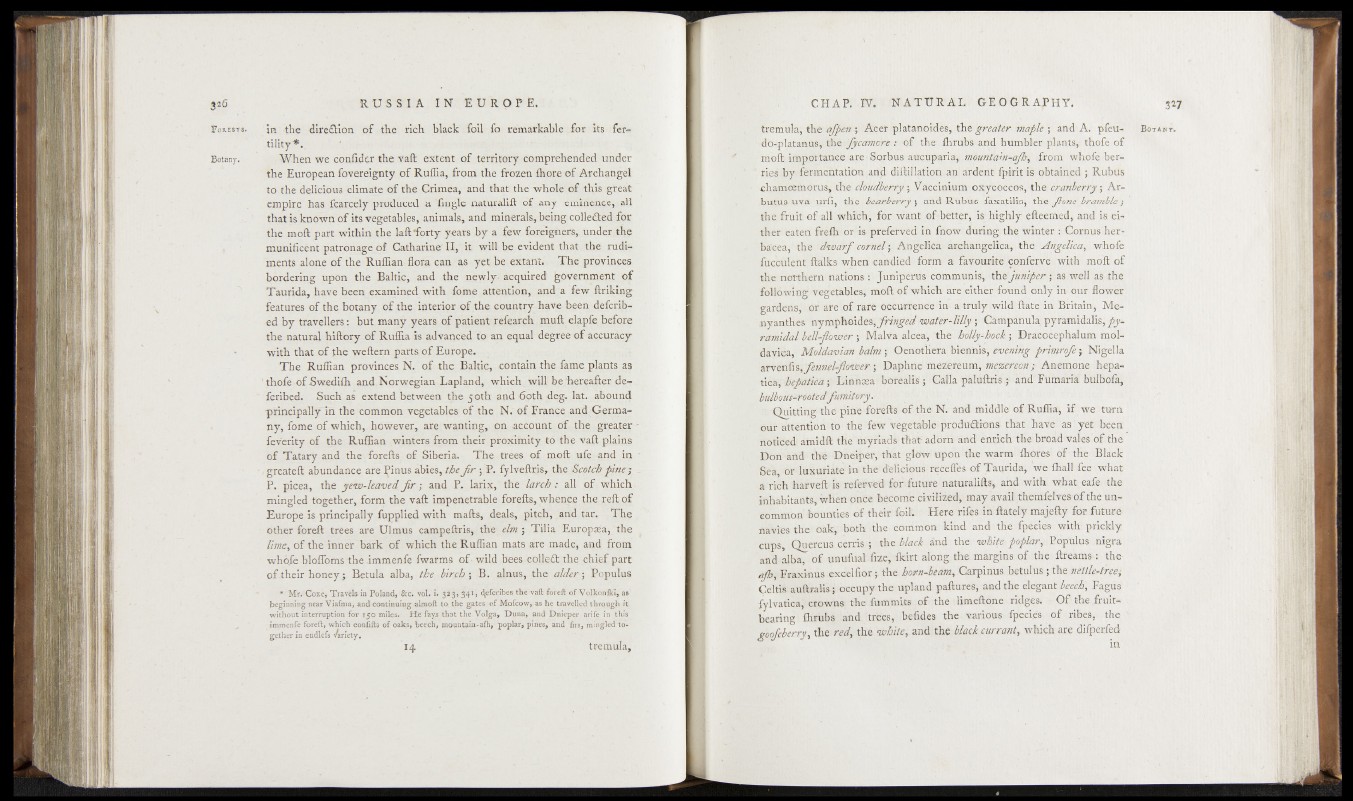
F o r e s t s .
Botany.
in the dire&ion of the rich black Toil.fo remarkable for its fertility*.
When we confider the vaft ex-te^t-of territory comprehendedUifS&er
the European fovereignty o f Ruffia, from the frozen fbore of Archangel
to the deficioua climate qf the Crimea, and thatiftef wh®lft^P;tl^»^t!eat
empire has Scarcely produced a Tingle naturalift of any eminepce,, all
that is known'of its vegetables, animals, and mineral vbeing colleSted; for
the moft part within the laft*forty years by a few foreigners, .under; the
munificent patronage, of Catharine' II,' it will be evident thatpfthe rudiments
alone o f the*Ruffian flora, can as yet be extant. - The provinces
bordering upon the Baltic, and the newly;, acquired government o f
Taurida, have been examined with feme attention, apd a few ftriking
features of the botany of the; interior o f the country have h^ei^defcrib-
ed by travellers: but many years of patkntrefearch muft elapfe,jbefore
the natural hiftory of Ruffia is advanced “to an equaTdegree^qf accuracy
with that of the weftern .parts, o f Europe. .5
.’The Ruffian provinces N. of-the Baltic, contain the fame plants a3
thofe of -Swedifh and Norwegian Lapland, which, will be hereafter de-?
feribed. Such as extend between the 50th and ■69th dqg^ht. aboupd
•principally in the common vegetables of the N.~ of France apd >Germa-
oy* fojne of,which, however, are wanting, gp, accppfi^ of, the greater
feverity of the Ruffian winters from their proximity tertife’ va%^lain§
of Tatary and the forefb of Siberia. The trees of moft u|e^and in
■ greateft abundance are £inus abies, the f i r ; P. fylveftris» the Scotch fine-}
P. picea, ffie yew-leaved, f r y and P. la r i^ th e -l&ffkr.: all of.which,
mingled together, form the vaft impenetrable forefts, whcpce^tligj reft of
Europe is principally fupplied with malts, deals, pitch, -and tar.. - The
oth^ foreft trees are Ulmus campeftris, the \ dm, ; TMia Europa^a, "the
lime, of the inner bark of which the Ruffian mats are made, and fr&tjn
whoffi bldfloms tMimmenfe fwarms of-wild beescolleft the chief part
o f their honey j Betula alba, tpe -.bir^h % >B. alnus, the .g/ldepy Populus
* Mr.-Goxe, Travels in Poland,-&c. vol. i. 323, 341, dfferibes the vaft foreft b'f.i as
beginning near V iafma, and continuing almoft to the gates o fM o fcow , as he travelled through it.
without interruption for 150 miles. H e fays that the V o lg a , Duna, and Dnieper arife in 'this
immenfe foreft, which confifb o f oaks, beech, mountain-ally poplar, pines, and . firs, mingled together
in endlefs variety,
14 . ■ tremula,
tremula, xhzafpen?, Acer platanoides, the greater maple ; and A. pfeu-
K h ^ k ta n u s v ^ d f |)0 n 2 ^ o h i? io f the h um b k ^ p ja n t^ tfiofe o f
roe%imp#itanee are whaftoher*
' ripi^y^Irffie^atTOOjan^i diftillarion$ap|"af-d8$f? y. Rubds
chamoemorus, th^j dbu ibt ; Litcciffiiuin Q^rf&tcp^f^h&^anfiepky ; Arbutus*
uv.a* 'iftfi, the %,b,ecw§b<epr,j 5 arid; RubUis. iSkaUhsj
thdTruit of all which,fforSj^ant; ofibeftef ^ tjsfhighly and is'dither
eaten frpfhp^ m ‘ft^^tiurinffithfe vteihter. taCornus her*,
hhcea,' x ^ i'M w ir f c e t n d AiijfdfljU-' .us^l'a-ngdioa, the whpfe
fucoulent- ftalks ^hillfcaiitiifgd$ feriwll favour-ite' bonfutsi’ty .whhwmoft of
'tire nOTthcni' narions.:-- Ju^|^^u^c^®h^$^thefy»^T4^fcas'w.eir'.aaitho
foll6win^vtegeffiblcsf‘.moft^bfV'Mi!®'Si^;eMD^^®fahar0f^ in ourfibwer
gardens, .or arelof rare ©eeuterence f i s k , f t ^ t e in Britaifoy Meaty
antHes nymphdides}J^«g5fiii?'.izy^4^'-^;%',;^i@^!iiipanula; pyra'm?d£l|s|>&i
•fcarvid'cddeiifo’i&'er, ; Malva,
daVi%, Moldavian
? Anemone, jhppatie
», ’tefOtieii ;V-MStsed%Mdali^ ;f:>6Mla pailuftnis'ff- atfdurna'rM bhffid6t|
bulbots^ii>t‘e:difaffiitory. ■ ‘ ■
S^^littiri'g^the"''ftifeToi4ft^ of-the N. a»d smldfil^^RuffiaT i£i,we''.ti!frn '
Ouf attentt6ri'‘fo*!fhe ‘few vegeMrle-^rodtfdron^ tbaif haveSfe^ yCfffbeen
fibticed« ainidft the myriads- thaV' adffiMf and eri^hh the5b»bad'Vaks*of|fce
®ou!ahd> tife Dnfe^c^/4hat glcftViu ^ ^ ’hhO'w’arm>ffh6fBst 6fciifieb®lsack
Se^, -or' luxuriate-in the dClicioa^&ffii of ^ - i^M ^W fh a il^ s ^ h a t
a ri^h harVefti is:- refewed fo'rfuture naturaliftffj and.,with whab:@afeiifthe
'»habitants, wheu'pnie hecomfe cmlked^ may avail ,therdfeiyes?p|the uh^f-
Common htiuhries of .theirToih ^ -Hererlriiesfikfktely majeftf for future
navies the Oak, -both the common JffihcL''‘aUd''the ‘fp^ci'd» with prickly
cups, Quercus cerris*? KthpMacA £nd',thej -white, , n i g r a
and alba^' Of unilifuaMze, fkirt along-. theLmar^a^^lt|^ft%am&i:,' the,
«/&, Fsa-xifap iexcelfiori y tire horn-beam, f&rpinus 'hetulUs; theMtitlertre?}
Cdti&auft'ralisj occupythe upland pafturesj -and the Fagus'
fylvaticaji crowns thefummits of-'the limeftdne ixidges»
bearing ffirubs and 'trees, befides the various4fp|ec:Ms. -}of ribes,. t-h'e |
gpfeberry, the red, the white, and the bhcksurrcmt, which are ffifpeofedr
B otAk t .